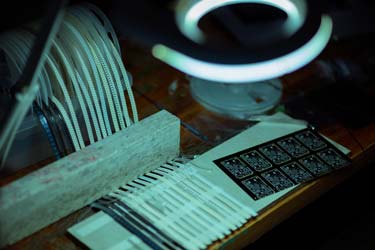-
As computational devices evolve, more tools and interfaces are built between the user and the machine. This allows us to complete increasingly complex tasks without having to focus so much on understanding the nuances of the machine. While this movement is certainly overall positive, one of the drawbacks is that people no longer learn the fundamental processes and concepts which allow the tool to work. Added to that, by neglecting history, we forget the alternatives of the technologies that we use today - forgotten alternatives that maybe once were the status quo. Understanding of those alternatives would give us a broader view of the pros and cons of what we have today, how they superseded their ancestors and what are their pitfalls - important knowledge for those who design possible futures.
More info →
Its with these preocupations in mind that Linobyte came into existence. It conciliates the explanation of how bits, bytes and chars work, with a hands on experience of creating Core Rope ROMs: read-only memories that were written by weaving an enameled copper wire through ferrite cores. -
Exploration of the difference between the real and the virtual (assumed) positions/characteristics of a thing due to noise in data assessment. This exploration was born from the desire to work with a part of data which we struggle a lot to get rid of: noise. During this constant struggle and maintenance, we do not necessarily realize how much noise we are removing.
More info →
By leaving only noise and integrating the noise into speed, and then into distance (as would be done with real “valuable” data), we can visualize how much we would believe the part traveled without proper “information maintenance”. This concept not only relates to sensors, but also to how we can erroneously or distortedly assess informations about people, the world, relationships. As we cannot integrate the error of an assessment of a person over time, we are left to use sensors as metaphors. -
Hardware custom designed and built to run Deep Locals Anypixels.js at Google Headquarters Brazil. Due internal reasons, I was asked to redesign all the hardware (of which I built 100+ controller boards manually), Vitaliano Palmieri did the Firmware, adapted Anypixels.js and programmed some custom animations. Felipe Sztutman and GTM Scenography were responsible for putting it all together.
More info →
This project was a technical and logistical tour de force. Google gave us the green light for the project mid February of 2017. In April 2017 it was installed and working.
It consists of approx. 7000 RGB backlit buttons, ~150 large PCBs (30k components placed by Fab House), ~150 small controller PCBs (5k hand placed components), ~25 RPis (~25 custom RPi shields), 2 servers and 2 UPS. -
Mechanical comic strip distributer. Designed and built in conjuntion with Marcio Ambrosio, from Kosmo.
More info →
After the success of the 2012 'Paper Spitters', which toured through many of SESCs buildings through the state of São Paulo, SESC asked Kosmo to build two more for the 2014 International São Paulo Book Bienal.
We decided to maintain the same main structure that we had on the first one, however this time we chose to also use 3D Printing, replace the DC Motors for stepper motors, mechanical endstops for optical ones, and acrylic gears for 3D printed gears and rubber timing belts.
As in the other first one, we sketched the mechanisms together, Marcio designed and printed most of them, and I was responsible for the electronics and firmware. -
Based on littlebits.cc.
More info →
For an exhibition about history of toys, at SESC Pompeia, my friend Radames Ajna was tasked to import Little Bits for an interactive space. Considering the scale of SESC Pompeia, we then proposed an alternate solution: why not build little bits on the scale of a wall, where it would be easier for a crowd to interact with and view? Thus Big Bits was born. I created a logo and visual identity, redesigned the electronics and designed the mechanical parts, while Radames programmed the firmware where necessary and managed the fabrication of the parts (he also had other responsabilities in other parts of the exhibition). -
Interactive musical sequencer. Interaction was made through detection of finger position (LEDs) through blob detection on Processing. One of the fingers was the cursor, and if the other finger got close enough the program registered a 'click'.
More info →
Group project for 'Visual Design 6' course at University of São Paulo, with Prof. Daniela Hanns and Prof. Ricardo Nakamura.








